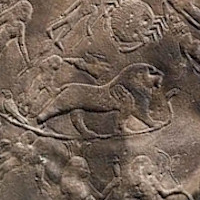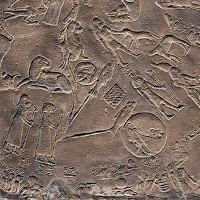ARTICLE

Astronomical and astrological representations in ancient Egypt's buildings and objects.
Initially and like many other people, the ancient Egyptians looked at the stars to organize cults, ceremonies and agricultural activities. For example, they noticed the Nyle river used to cause floods at the beginning of the Summer, when Sirius star was visible for the first time before sunrise. The view indicated the beginning of the agricultural cycle and a new year.
By those times, the Egyptians mainly looked at a band of 36 stars, and assigned groups of three of them to each month, as Ancient Babylonian astronomers did. They related them to the Zodiac just during the V-VI c. b.C., when the signs were introduced from the Mesopotamy, too. Then, the stars were called deans, and each one of them ruled 10° of the celestial dome.

In the image, the brightest star, at the bottom and centered, is Sirius in Canis Major, forming a kind of a triangle along with Procyon in Canis Minor (upper left) and Betelgeuse in Orion (upper right). Credit: © Akira Fujii.
The stars were used to measure nighttime since the observers counted the hours as they were rising. The study of the engraves on which they were represented allows reconstructing the celestial domes for the moment in the sky the Egyptians wanted to allude to. But when those stars were related to the signs, it was easier to identify their equivalences by considering right ascensions! In all of those engraves on which the deans remained not associated to signs, identifying them is still a matter of study to decode the equivalences.
The integration between deans and signs can be appreciated, for example, at a Dendera's temple built during the Ptolemaic Age (323-30 b.C.) in Upper Egypt. Meant to worship Hathor, the goddess of fertility, a low-relief sculpted on the ceiling in one of the chambers dedicated to Osiris represents a circular planisphere, and it's considered to be the horoscope of the world, with stars placed where they supposedly were in the sky at the date they considered for the event.


Zodiac in a temple's ceiling, near Dendera. Touch the image to locate the zodiacal signs.
Initially, the planisphere was around 141" x 94" x 35" and weighed almost 20 tons. In the most external area, it's supported by Nut, the goddess of Heaven, drawn as four female characters in the four directions, representing the pillars supporting the sky. Between them, there are 8 paired hawk-head kneeled characters. From the central point to the periphery:


The central point is the North Pole with three constellations: Canis Major as a bull's leg, Canis Minor as a little jackal, and Draco as Tuaret the hippopotamus.


The Zodiac now is all around the central constellations, for example Sagittarius.
On Dendera's ceiling, the signs were drawn according to the Mesopotamic tradition, which was inherited by the Egyptians:








Touch the image to locate the positions of Venus (between Aquarius and Pisces), Mars (in Capricorn), Saturn (between Virgo and Libra), Mercury (in Cancer) and Jupiter (between Cancer and Gemini).
In between the signs, the five planets known by that time are emplaced where they were at the time the world was born. Between Leo and Taurus, and towards the periphery, there are Orion constellation and Sirius star. The 36 deans considered in ancient times were now represented as figures all across the border, as it can be appreciated in the bigger image above, and five of them are aligned with the planets, which made it easier to track the date of the astral configuration alluded to by the relief.
But the zodiacal signs were also integrated into mortician representations, usually drawn inside of coffins to last forever, as part of the funeral trousseau of the owners. Like in the Zodiac at Dendera's temple, the main character in the coffin is Nut again, with opened arms to protect the deceased's mummy. The 12 signs display the Mesopotamic iconography, and are represented around the goddess' body, too. At the bottom, from left to right: Leo, Virgo, Libra, Scorpio, Sagittarius and Capricorn. At the top, from right to left: Aquarius, Pisces, Aries, Taurus, Gemini and Cancer.
Imaginary vertically aligned axes (in the picture displayed here) connect signs according to ancient planetary rulerships. From left to right: Gemini-Virgo & Mercury; Taurus-Libra & Venus; Aries-Scorpio & Mars, Pisces-Sagittarius & Jupiter, and Aquarius-Capricorn & Saturn.
The axes' ordering in the sequence follows the classic way to register planetary positions in the ephemeris. Except the first axis, and from left to right in the picture: Mercury (Virgo-Gemini), Venus (Libra-Taurus), Mars (Scorpio-Aries), Jupiter (Sagittarius-Pisces), and Saturn (Capricorn-Aquarius).

Sources: PressReader.com – Digital Newspaper & Magazine Subscriptions, Propuesta de investigación de estrellas y constelaciones egipcias de la lista decanal del techo astronómico de Senenmut En Deir El-Bahari by José Lull, ESA, Babylonian astronomy.





Comments
Join and leave a message. I always answer personally, and as soon as possible.